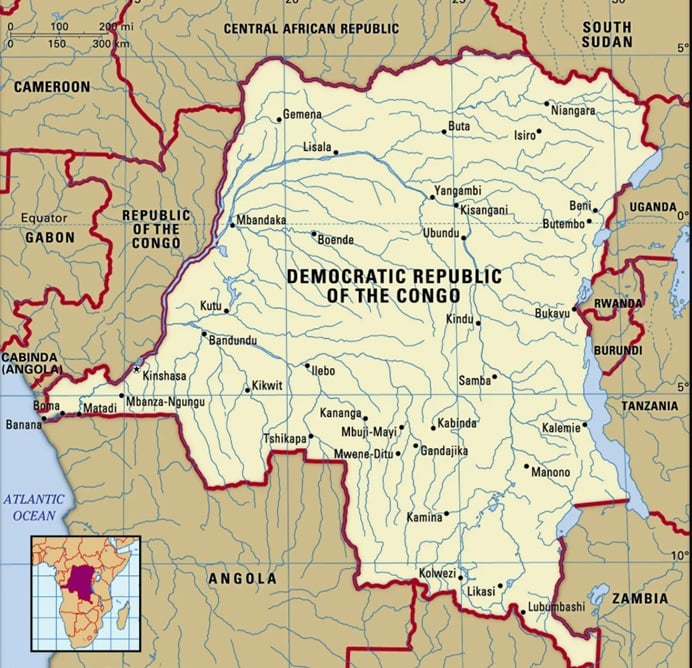
February 9, 2025
Caleb T (Dr.)
The Democratic Republic of Congo (DRC), a nation blessed with unparalleled natural wealth, is once again embroiled in conflict, raising profound concerns about regional stability and the exploitation of its vast resources (The Evidence That Shows Rwanda Is Backing Rebels in DR Congo, 2025). The resurgence of violence, allegedly fueled by Rwanda’s indirect intervention, echoes a troubling pattern of external interference and resource plundering that has plagued the DRC for decades (The Evidence That Shows Rwanda Is Backing Rebels in DR Congo, 2025). This essay aims to delve into the complexities of the situation, examining the historical context, the key actors involved, and the potential consequences for the DRC and the African continent as a whole.
A Legacy of Tribal Divisions and External Interference
The roots of the DRC’s instability can be traced back to the arbitrary drawing of African borders by European colonial powers, which often disregarded existing ethnic and cultural boundaries (The Evidence That Shows Rwanda Is Backing Rebels in DR Congo, 2025). This legacy has led to persistent tribal tensions, most notably between the Hutu and Tutsi communities, who find themselves divided across Rwanda, the DRC, and Uganda (The Evidence That Shows Rwanda Is Backing Rebels in DR Congo, 2025). The Rwandan genocide of 1994, in which approximately 800,000 Tutsi and moderate Hutu were massacred, further exacerbated these tensions, as Hutu perpetrators fled to eastern DRC, leading to subsequent Rwandan interventions in the name of pursuing these groups (The Evidence That Shows Rwanda Is Backing Rebels in DR Congo, 2025). However, these interventions have often been criticized for masking economic motives, particularly the exploitation of the DRC’s rich mineral resources (DR Congo Crisis: What Roles Are Rwanda, Burundi, Uganda Playing?, 2025).
Rwanda’s Role: Defense or Exploitation?
Rwandan President Paul Kagame has consistently denied allegations of supporting rebel groups in the DRC, claiming that Rwanda’s primary concern is to address the threat posed by the Democratic Forces for the Liberation of Rwanda (FDLR), a Hutu rebel group comprised of individuals responsible for the Rwandan genocide (The Evidence That Shows Rwanda Is Backing Rebels in DR Congo, 2025). However, numerous United Nations reports and other credible sources provide evidence of Rwanda’s support for the M23 rebel group, including the provision of weapons, training, and even direct military intervention (The Evidence That Shows Rwanda Is Backing Rebels in DR Congo, 2025). These reports detail the presence of Rwandan military officers in M23 camps, the supply of advanced weaponry, and the use of Rwandan technology to disrupt Congolese military operations (The Evidence That Shows Rwanda Is Backing Rebels in DR Congo, 2025). Critics argue that Rwanda’s actions are not solely driven by security concerns but also by economic interests, particularly the exploitation of the DRC’s vast mineral wealth (DR Congo Crisis: What Roles Are Rwanda, Burundi, Uganda Playing?, 2025).
The Illicit Mineral Trade: Fueling Conflict and Enriching Neighbors
The DRC is renowned for its immense mineral wealth, including significant reserves of coltan, a crucial component in electronic devices (Christopher P. Davey, 2024). Despite being the world’s top producer of coltan, the DRC’s neighbor, Rwanda, has emerged as a major exporter of the mineral, raising suspicions of illicit trade and resource exploitation (Christopher P. Davey, 2024). UN experts have documented how the M23 rebel group controls key mining areas, such as Rubaya, and generates substantial revenue through taxation of coltan production and trade (The Evidence That Shows Rwanda Is Backing Rebels in DR Congo, 2025). This revenue is then allegedly used to finance the rebellion, perpetuating the cycle of violence and instability. The advanced weaponry and technology employed by the M23, often surpassing that of other armed groups in the region, further underscores the scale of external support and the lucrative nature of the illicit mineral trade (The Evidence That Shows Rwanda Is Backing Rebels in DR Congo, 2025).
The Humanitarian Crisis: A Devastating Toll on Congolese Lives
The ongoing conflict in the DRC has resulted in a dire humanitarian crisis, with millions of Congolese people displaced from their homes, facing food insecurity, and lacking access to basic services (The Evidence That Shows Rwanda Is Backing Rebels in DR Congo, 2025). The violence has also led to widespread human rights abuses, including mass killings, sexual violence, and the recruitment of child soldiers (The Evidence That Shows Rwanda Is Backing Rebels in DR Congo, 2025). The UN estimates that nearly 3,000 people have been killed in the recent surge of violence, and the number is expected to rise (Larry Madowo, Catherine Nicholls, Nimi Princewill, Sarah Dean, 2025). The capture of Goma, a major city in eastern DRC, has further exacerbated the humanitarian crisis, disrupting aid delivery and leaving hundreds of thousands of displaced people without access to essential supplies. The M23’s actions, such as attacking displacement camps and interfering with humanitarian operations, have drawn strong condemnation from international organizations and human rights groups (The Evidence That Shows Rwanda Is Backing Rebels in DR Congo, 2025).
A Continent Denied: The DRC’s Potential for Transformation
Beyond the immediate crisis, the ongoing conflict in the DRC has far-reaching implications for the African continent as a whole. The DRC possesses immense potential to drive economic growth and development, not only within its own borders but across the entire continent. With vast arable land, abundant water resources, and significant hydroelectric potential, the DRC could become a major food producer and a source of clean energy for the region. The Grand Inga Dam project, with its potential to generate 45,000 megawatts of electricity, could power a significant portion of Africa, fostering industrialization and economic integration. However, the persistent instability and external interference have prevented the DRC from realizing its potential, hindering the progress of the entire continent.
A Call for Justice and Accountability
Addressing the complex challenges in the DRC requires a multi-faceted approach that tackles both the immediate humanitarian crisis and the underlying drivers of conflict. It is crucial to hold all actors accountable for human rights abuses and war crimes, including those committed by the M23 rebel group and any external forces supporting them. The international community must also take decisive action to combat the illicit mineral trade, implement stricter regulations on supply chains, and ensure that companies sourcing minerals from the DRC are not inadvertently funding violence and exploitation. Furthermore, regional and international actors must prioritize diplomatic efforts to foster dialogue and cooperation between the DRC and its neighbors, addressing legitimate security concerns while upholding the DRC’s sovereignty and territorial integrity (The Evidence That Shows Rwanda Is Backing Rebels in DR Congo, 2025).
Conclusion
The conflict in the Democratic Republic of Congo is a tragedy that demands urgent attention and concerted action. The exploitation of its natural resources, the involvement of external actors, and the devastating humanitarian consequences have created a complex crisis that threatens the stability of the entire region. By addressing the root causes of the conflict, promoting accountability, and supporting the DRC’s development, the international community can help unlock the country’s vast potential and create a more peaceful and prosperous future for its people and the African continent as a whole. The people of the DRC deserve nothing less than the opportunity to build a brighter future, free from the cycle of violence and exploitation that has plagued their nation for far too long (Larry Madowo, Catherine Nicholls, Nimi Princewill, Sarah Dean, 2025).
.
.
.
#Democratic #Republic #Congo #Nation #Plundered #ContinentHeld #Hostage #Habesha #Latest #Ethiopian #News #Insightful #Analysis
Source link











